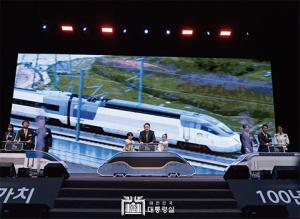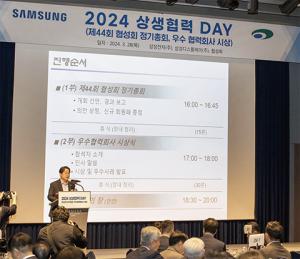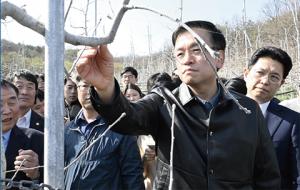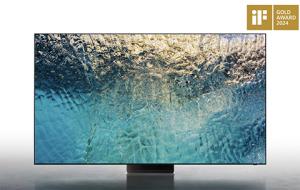 |
||
| ▲ President Jo Seung-hyun | ||
Traditionally, Koreans use a double-headed drum (janggu), a barrel drum (book), a large gong (jing) and a small gong (Kkwaenggwari) to form the unique Korean percussion quartet (Samulnori). Janggu sounds like rain, buk like base drum, jing like wind and kkwaenggwari like thunder. While jing and buk make sound like ‘the bass’ Kkwaenggwari and janggu leads the rhythm. It is rare that a single instrument of these four drums is performed independently. What makes Jo Seung-hyun, the president of the Korea Gogo Jangju Association, outstanding, in this respect, is that she singled out janggju (double-headed drum) and introduced a unique rhythm performance. <PowerKorea> met Jo and heard about the story.
23 years of single path
The Korea Gogo Jangju Association started in 1997 in the name of the Arang Theatre. It changed to the Arang Gogo Janggu Art House in 2013 and to the current name on the occasion of the approval by the Ministry of Culture, Sports and Tourism as a non-profit corporation in 2018. For the last 23 years since the initiation in 1997, Gogo Janggu has fostered many talented traditional musicians and performers as well as instructors under the motto ‘Gogo Exhilaration’.
Gogo Jangju has grown to have 60 branches nationwide as of 2019 and is giving lessons and performances at many cultural centers, welfare centers, schools and companies. It won the gold prize at the Korea Pumba 2010, the grand prize at the Eumseong County Pumba Festival 2012 and 2013 and another grand prize at the King of Kings. It appeared on KBS1 AM Plaza, Open Concert, I Like to Sing, National Singing Contest, and Music Bank.
The 6 classes cover all level of people from beginners to advanced which in particular accompanies choreography. Everybody who has interest in learning traditional Korean drums and performances can join a class according to their level.
“Gogo Janggu is built based on the traditional 4/4 rhythm on which our ancestors played musical instruments. What I did was that I drew this stage-based performance to people-participatory so that more people can easily enjoy our traditional musical instruments” explained Jo.
Inspiration
25 years ago, Jo happened to see a Korean drum performance and was instantly enchanted by double-headed drum. She still remembers the moment vividly that it was fateful event she was there on that day. Interestingly though, Jo never learned the skills from master double-headed drummers but taught herself. She ascribes this to the reason of developing her unique Janggu rhythm and style which she published in a book in 2015 with English subtitles and even made DVD in 2017. January this year, Jo invited 17 branch heads and 2,000 people of all walks of life to the Gwangmyeong Gymnasium for the initiation of the Korea Gogo Janggu Association alongside the 1st Korea Gogo Janggu Festival.
Spreading the exhilaration of Gogo Janggu
While dispatching Gogo Janggu instructors as far as to Australia and instruction DVD to Los Angelis US, the Korea Gogo Janggu Association issues 1st grade instructor’s certificate to those who gained more than 90 scores at a test and 2nd grade to those who gained between 70 and 90. Everybody can learn Gogo Janggu as the movements are easy such as clapping or shouldering up and down while drumming.
“It is my goal to open 100 branches nationwide in near future. As for the coming events, we are holding a performance for elderly living alone at Gwangmyeong Gymnasium this September and at the Jinju Gaecheon Art Festival and at Seoul Plaza in October. We are also planning a large scale performance festival May next year at Gwangmyeong Gymnasium by inviting 5,000 people and another one within 2 years at Jamsil Arena during which 10,000 performers give a synchronized Janggu play.”
강진성 기자 wlstjdxp@naver.com







